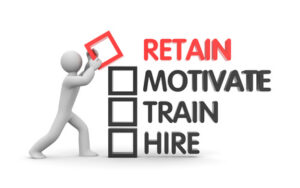 With employee quits continuing to outpace layoffs at a 2:1 ratio, executives now consider retaining top talent a higher priority than employee engagement or even cost management.
With employee quits continuing to outpace layoffs at a 2:1 ratio, executives now consider retaining top talent a higher priority than employee engagement or even cost management.
Considering the growing costs of replacing employees (things like money, time, talent, intellectual property, to name just a few), retaining top talent is a necessary corporate strategy. Today’s HR leaders can leverage extremely powerful technologies to help reduce attrition, such as pinpointing flight risks via predictive analytics, or using advanced AI surveys to reveal real-time employee sentiment.
But while these technologies are extremely valuable for evaluating the current workforce, the most effective retention campaigns include practices that begin long before sending the offer letter.
Recruiting is much more than a tactical function. Talent acquisition should have an influential seat at the table, actively partnering and integrating with talent management and succession-planning strategy.
Here are four (4) strategies that can enhance organizational recruitment efforts, strengthening the employee base and helping in retaining top talent as well:
1 – Begin with the candidate in mind
Teams should create a detailed candidate profile, fine-tuning expectations and desired traits for the role to form a clear vision of the ideal hire.
I highly suggest also assessing cultural fit and drive in addition to experience and verifiable competencies, as these key personality traits play a major role in attrition. This specific candidate profile will tailor the hiring process to attract not only the top talent, but the top talent who are likely to contribute to the organization — and culture — long-term.
 I like using Design Thinking methodology to develop ideal personality profiles. The five steps endorsed by the Stanford Institute of Design — empathize, define, ideate, prototype, and test — encourage talent acquisition teams to develop candidate-centered methodology and innovative new ways of identifying people who “fit” with your organization’s culture and are likely to stay. This includes collaboratively ranking candidates and utilizing specialized testing vehicles to assess their skills.
I like using Design Thinking methodology to develop ideal personality profiles. The five steps endorsed by the Stanford Institute of Design — empathize, define, ideate, prototype, and test — encourage talent acquisition teams to develop candidate-centered methodology and innovative new ways of identifying people who “fit” with your organization’s culture and are likely to stay. This includes collaboratively ranking candidates and utilizing specialized testing vehicles to assess their skills.
Consider Steve Jobs’ legendary quote:
It doesn’t make sense to hire smart people and then tell them what to do; we hire smart people so they can tell us what to do.”
Culture is heavily based on trust and respect, so leaders should strive to deliver an experience where candidates feel comfortable and confident sharing their ideas, even during the interview process. You should want (and expect) employees to challenge the status quo so they can continue to make your culture, products, and services better.
2 – Uncover innovative recruitment opportunities
Think beyond traditional marketing strategies to find exciting new ways to reach potential hires. Design Thinking helps with this, too.
Carefully consider how ideal candidates spend their free time, what web sites they might be using, and how they’re likely to respond to a different approach. Then, develop a plan of action, and test it, then try something else, test again, reconsider, and repeat in a non-linear fashion.
Consider utilizing unconventional online platforms like Reddit in your efforts. By joining in discussions about current technology topics, recruiters are able to interact with viable candidates in a friendly, informal way and share information about offerings with people who match their ideal profile.
3 – Make sure to make it a team effort
The people we work with can have a substantial impact on our engagement and satisfaction, as well as our retention, which means leaders owe it to their teams — and their organization — to prioritize personality and cultural fit.
Employee feedback should play a primary role in recruiting. Teamwork is a critical aspect of nearly every position, so hiring managers should include the candidate’s future peers in the interview process and give significant weight to their observations and opinions. This has a huge impact on culture, overall work environment, and employee retention.
4 – Deliver skill-based assessments
Here’s something I highly recommend: Having candidates on your “short list” take assessments to ensure they possess the necessary skills for the role.
It’s incredibly illuminating to watch someone attempt to solve a problem. Analytical assessments are fantastic at gauging critical, numerical, and abstract reasoning, while cultural-assessment analyses can be leveraged to reveal a candidate’s work style, people acumen, drivers, and values.
Although they aren’t perfect, these tests are likely to raise red flags if any of your top picks are ill-suited for the position — and, therefore, unlikely to stay.
Finding the right person to fit in a role, a team, a corporation, and a culture can be daunting, but keeping long-term retention, especially retaining top talent, in mind is worth any extra effort and time spent during the hiring process.
Authors
Adam Rogers
Adam Rogers is the CTO of Ultimate Software, where he began his career in 1997 as Ultimate Software's very first intern and quickly became a leading innovator in the field. In 2002, Adam led his team to deliver the very first Software-as-a-Service (SaaS) cloud Enterprise solution, redefining industry standards by bringing HCM to the cloud. Today, he serves Ultimate as CTO and holds the unique distinction of leading both product innovation and corporate IT strategy. Adam's teams are routinely recognized for their industry-leading innovations and Adam's thought leadership work is regularly published in Forbes, InformationWeek, and a variety of online blogs and publications. You can follow Adam on Twitter @adamr or connect with him on LinkedIn.
Recruit Smarter
Weekly news and industry insights delivered straight to your inbox.





